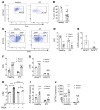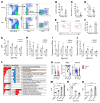The ZIP8/SIRT1 axis regulates alveolar progenitor cell renewal in aging and idiopathic pulmonary fibrosis
- PMID: 35389887
- PMCID: PMC9151700
- DOI: 10.1172/JCI157338
The ZIP8/SIRT1 axis regulates alveolar progenitor cell renewal in aging and idiopathic pulmonary fibrosis
Abstract
Type 2 alveolar epithelial cells (AEC2s) function as progenitor cells in the lung. We have shown previously that failure of AEC2 regeneration results in progressive lung fibrosis in mice and is a cardinal feature of idiopathic pulmonary fibrosis (IPF). In this study, we identified deficiency of a specific zinc transporter, SLC39A8 (ZIP8), in AEC2s from both IPF lungs and lungs of old mice. Loss of ZIP8 expression was associated with impaired renewal capacity of AEC2s and enhanced lung fibrosis. ZIP8 regulation of AEC2 progenitor function was dependent on SIRT1. Replenishment with exogenous zinc and SIRT1 activation promoted self-renewal and differentiation of AEC2s from lung tissues of IPF patients and old mice. Deletion of Zip8 in AEC2s in mice resulted in impaired AEC2 renewal, increased susceptibility to bleomycin injury, and development of spontaneous lung fibrosis. Therapeutic strategies to restore zinc metabolism and appropriate SIRT1 signaling could improve AEC2 progenitor function and mitigate ongoing fibrogenesis.
Keywords: Adult stem cells; Fibrosis; Pulmonology; Stem cells.
Conflict of interest statement
Figures







Comment in
-
Deficiency in the zinc transporter ZIP8 impairs epithelia renewal and enhances lung fibrosis.J Clin Invest. 2022 Jun 1;132(11):e160595. doi: 10.1172/JCI160595. J Clin Invest. 2022. PMID: 35642632 Free PMC article.
References
-
- American Thoracic Society. Idiopathic pulmonary fibrosis: diagnosis and treatment. International consensus statement. American Thoracic Society (ATS), and the European Respiratory Society (ERS) Am J Respir Crit Care Med. 2000;161(2 pt 1):646–664. - PubMed
-
- Jiang D, et al. Stem cells and progenitor cells in interstitial lung disease. In: Janes SM, ed. Encyclopedia of Respiratory Medicine. 2nd Ed. Elsevier; 2022:158–168.

